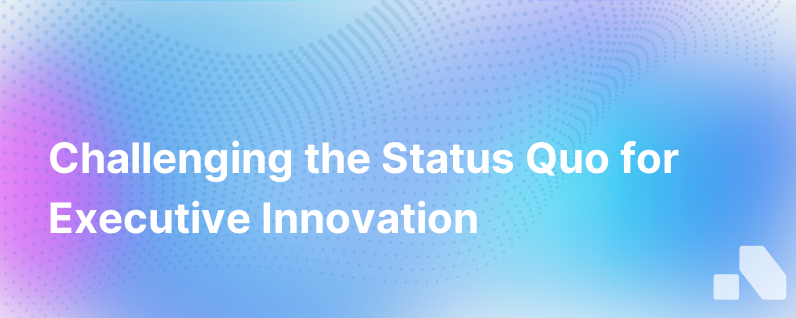
In today's ever-evolving business landscape, clinging to the status quo is tantamount to signing your company's own obsolescence certificate. The status quo—defined as the existing state of affairs—while providing a temporary comfort zone, can be a dangerous trap for any business. It is when organizations grow complacent that they are most vulnerable to disruption.
To avoid this pitfall, businesses must embrace change, challenge existing assumptions, and champion innovation. In this article, we will undertake an extensive exploration of why breaking the status quo is essential, how it can benefit your company, and practical strategies to inspire change and foster an innovative environment.
The Risk of Complacency
The business graveyard is filled with the headstones of companies that failed to adapt. Consider how Blockbuster laughed off Netflix’s proposition or how Kodak, once a titan of photography, filed for bankruptcy because they underestimated the digital revolution. These tales of corporate demise serve as sobering reminders of the high cost of complacency.
Innovation necessitates the shattering of the status quo. It’s about questioning the 'we’ve always done it this way' mentality and exploring 'what if' scenarios with curious minds. Companies entrenched in the status quo are playing a perilous game, especially when smaller, more agile startups are looking to capitalize on market opportunities overlooked by industry giants.
Benefits of Breaking the Status Quo
Increased Competitiveness
By embracing innovation, companies remain at the cutting edge, offering products or solutions that outpace the competition. Being first or early in adopting new technologies or practices can provide a critical competitive advantage.
Enhanced Customer Satisfaction
Innovation often leads to better services and products, which typically translates directly into increased customer satisfaction and loyalty.
Improved Employee Engagement and Retention
A culture that questions the status quo challenges employees to think creatively, fostering a dynamic, engaging, and fulfilling work environment that attracts and retains top talent.
Greater Agility
An innovative company can quickly pivot in response to market changes. This agility enables businesses to capitalize on new opportunities and mitigate risks more effectively.
How to Break the Status Quo
Foster a Culture of Continuous Learning
Companies should encourage continuous learning by providing resources and opportunities for professional development. A well-informed employee base is more likely to generate creative ideas that can disrupt the status quo.
Encourage Healthy Debate
Encourage employees to voice diverse opinions and challenge existing beliefs. Healthy debate can unearth assumptions that are blocking innovation and lead to breakthrough ideas.
Embrace Failure as a Stepping Stone
The fear of failure is a formidable guardian of the status quo. Businesses must celebrate well-intentioned failures as part of the learning process, thereby destigmatizing risk and inspiring boldness in innovation.
Set a Vision that Goes Beyond the Current State
Leadership must set an aspirational vision that galvanizes the organization. The vision should elucidate a future that’s significantly different from the present and aligns with overarching strategic goals.
Flatten Hierarchies Where Possible
Traditional hierarchies can stifle innovation. Flatter organizational structures often enhance communication and make it easier for ideas to be shared, evaluated, and implemented.
Collaborate and Diversify Perspectives
Cross-functional collaboration brings different perspectives to the table, reducing the likelihood of 'groupthink' and promoting insightful solutions that might not arise within a siloed team.
Leverage Data and Technology
Invest in data analysis to pinpoint inefficiencies and areas for improvement. Use technology as an enabler to streamline processes, enhance product offerings, and break free from legacy systems that reinforce the status quo.
Lead by Example
Change starts at the top. When leaders are willing to question their own decisions and seek out fresh approaches, they send a strong message that challenging the status quo is not only accepted but expected.
The Role of Technology in Breaking the Status Quo
The technology revolution has brought incredible tools and systems to bear for organizations willing to invest in them. Artificial Intelligence (AI) is at the forefront of this transformation. Platforms like Aomni can significantly alter the traditional sales approach. By providing real-time account research, competitive insights, and personalized sales content in a fraction of the time traditional methods require, Aomni supports sales teams to sell more strategically without the effort previously required.
With such platforms, companies disrupt their standard operations in a positive manner, driving productivity, and efficiency and enabling sales teams to outperform competitors still chained to outdated practices.
Conclusion
Breaking the status quo is essential for businesses seeking long-term success. Those who choose innovation and adaptability over comfort and complacency stand to gain not only in profitability and market share but also in relevance. By fostering a company culture that challenges norms and embraces change, organizations can set the stage for groundbreaking innovation and growth. Tools like Aomni personify the crux of this mindset shift, empowering businesses to redefine conventional processes and drive forward with purpose and agility in the modern marketplace.
It's clear that businesses must evaluate their existing state of affairs with a critical eye and muster the courage to forge new paths. Embrace innovation, question the present, and build your future – break the status quo, before it breaks you.